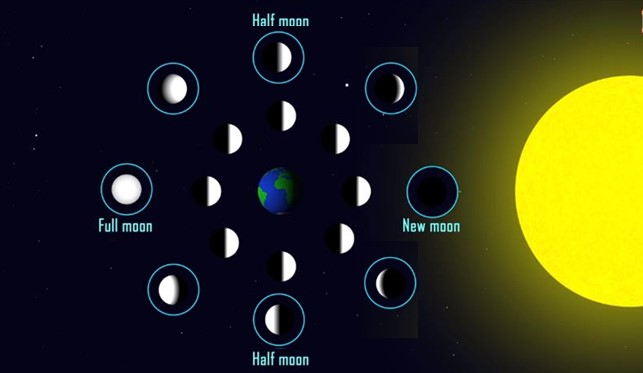The stars, the planets, the moon, comets, asteroids, meteors, meteorites and many more such objects that occupy space in the universe are called Celestial objects.
Moon
The moon is the brightest object in the night sky and the most visible thing to our naked eye. It does not produce any light of its own. It reflects the light of the sun that falls on it. It is this reflected sunlight that makes it possible for us to see the moon.
It completes one rotation on its axis as it completes one revolution around the Earth.
Phases of the Moon
The various shapes of the bright part of the moon as seen during a month are called Phases of the moon.
The shape of the moon changes every day. There are days when it is perfectly round and days when there is no moon at all. Let us learn about these phases a little bit more.
The day on which the whole disc of the moon is visible is known as the Full moon day. It’s
because the full side of the moon facing the earth gets sunlight.
As the moon orbits around the earth, the light from the sun to the moon decreases. When it makes a quarter of a revolution, we see half a moon.
When it completes half an orbit, we cannot see it at all. This is because the side of the moon facing the earth does not get sunlight. This phase of the moon is called the New moon.
The next day, only a small portion of the moon appears in the sky. This is known as the crescent moon.
The time taken for a full moon to change into a new moon is around 15 days.
After the new moon, the moon orbits the other half, making one full circle around the earth, where it becomes a full moon again. It takes another 15 days approximately for a new moon to change into a full moon again.
The period between one full moon and another full moon is roughly 29 days.
Moon’s surface
It has a really dusty and barren surface. It also has a number of steep and high mountains that are as high as the mountains on earth. It also has a considerable number of craters of different sizes.
The moon has no atmosphere. Hence, there is no oxygen, no water, and no sound.
Summary
| Celestial Objects | The stars, the planets, the moon, comets, asteroids, meteors, meteorites and many more such objects that occupy space in the universe |
| Phases of the Moon | The various shapes of the bright part of the moon as seen during a month |
| Full Moon Day | The day on which the whole disc of the moon is visible |
| New Moon Day | The day on which the moon is not visible at all |
| Moon’s Surface | Dusty and barren
Steep and high mountains Many craters of different sizes No atmosphere, hence no oxygen, no water and no sound |
Did you know?
The largest crater on the Moon is called the South Pole-Aitken (SPA) basin. It is 2,500 km in
diameter and 13 km deep. It can’t be seen from Earth because it’s on the far side of the Moon.

